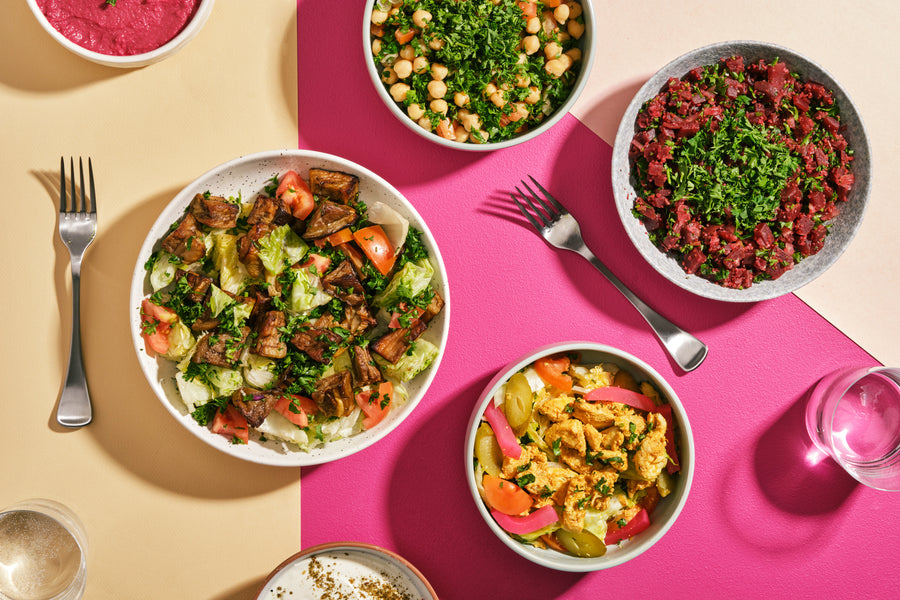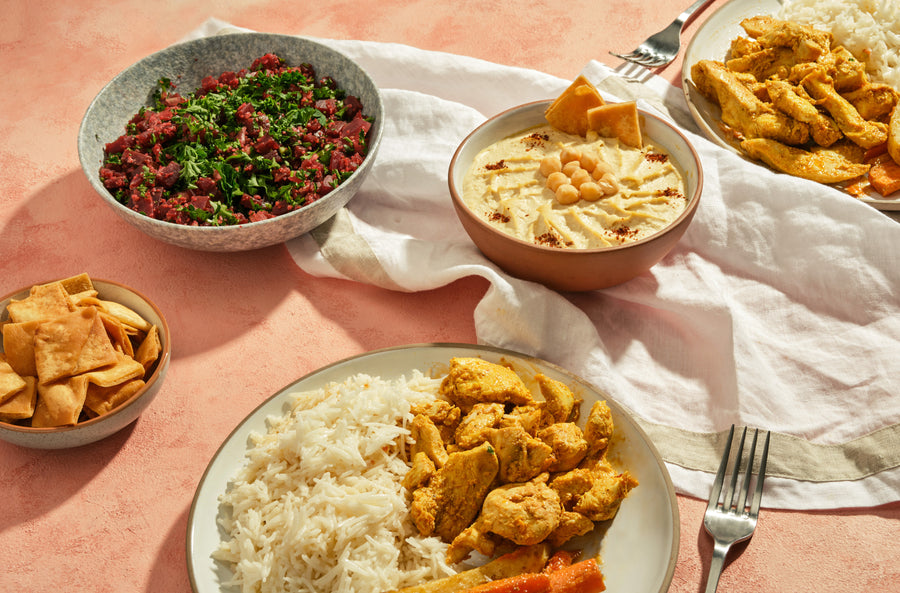Afternoon Tea Vancouver Etiquette: Traditions Explained
All Regarding the Rich Flavors and Traditions of Syrian Food: A Culinary Journey
Syrian cuisine offers an one-of-a-kind mix of flavors and traditions that show its abundant social background. With staple components like olive oil and garlic, alongside a selection of spices, the meals are both diverse and welcoming. From the complex prep work of kibbeh to the wonderful attraction of baklava, each element of this culinary landscape discloses much deeper stories. As one checks out the essence of these flavors, a better understanding of public dining and event emerges.
The Essence of Syrian Active Ingredients
The significance of Syrian ingredients exists in their rich variety and deep-rooted cultural importance. Influenced by the nation's varied geography and history, Syrian food incorporates a vast selection of seasonings, herbs, and fresh fruit and vegetables. Staples such as olive oil, garlic, and lemon give a foundation, while spices like sumac, coriander, and cumin include deepness and complexity to dishes.The usage of fresh herbs, including parsley and mint, highlights the importance of seasonal components. Additionally, the region's productive dirt returns a wealth of vegetables and fruits, such as pomegranates, eggplants, and tomatoes, which are important to several recipes. Grains like bulgur and rice create the base of several dishes, highlighting the significance of these active ingredients in Syrian culture. This blend of tastes shows not just a culinary practice yet also a tapestry of historical influences, making Syrian components necessary to understanding its cuisine's vivid character.

Iconic Dishes of Syrian Food
Syrian food is renowned for its iconic dishes that display an abundant tapestry of appearances and flavors. Conventional meze plates use a range of small recipes that entice the palate, while hearty main dishes give satisfying focal points for dishes (Afternoon Tea Vancouver). To finish the experience, an option of delightful treats adds a wonderful note to the culinary trip
Standard Meze Plates

Hearty Key Courses
Passionate main dishes offer as the centerpiece of Syrian dining, showcasing a mix of flavors that show the nation's rich cooking practices. Dishes such as kebab hindi, featuring seasoned lamb skewers, and the well known mujaddara, a calming mix of lentils and rice, highlight making use of fragrant flavors and fresh components. One more staple is the legendary kibbeh, made from bulgur wheat and minced meat, usually offered in various types, consisting of baked, deep-fried, or raw. In addition, the tastes of the land come alive in meals like stuffed veggies, understood as mahshi, which are loaded with rice, meat, and natural herbs. These main dishes not only please cravings but also tell stories of household celebrations and social heritage.
Delicious Treats Choice
A fascinating selection of treats defines the pleasant side of Syrian food, providing an alluring end to any dish. Among one of the most renowned confections are baklava, delicate layers of phyllo pastry filled up with nuts and saturated in syrup, and maamoul, shortbread-like cookies commonly packed with dates or nuts. Knafeh, a rich treat made from thin noodle-like bread soaked in syrup and layered with cheese, is a popular choice, especially during cheery occasions. In addition, the aromatic and sweet rice pudding, referred to as roz bil laban, gives a soothing coating. These delightful desserts not only display the region's cooking proficiency but additionally show the cultural heritage of Syria, making them treasured deals with in both restaurants and homes alike.
Typical Cooking Methods
Modern benefits have affected lots of culinary techniques, standard cooking strategies stay important to Syrian food. These techniques frequently stress making use of fresh, seasonal active ingredients and concentrate on slow-moving food preparation to develop abundant tastes. Methods such as grilling, braising, and cooking prevail, enabling the all-natural preferences of the components to radiate through.One notable strategy is the preparation of kibbeh, a recipe made from finely ground meat and bulgur. It calls for skillful hand-rolling right into different forms and can be baked, fried, or served raw. Additionally, the art of making bread, specifically pita, is main to many meals, frequently prepared in a typical stone oven.Preservation techniques like pickling and fermenting likewise play an important function, boosting the variety of tastes located in Syrian dishes. These strategies not just show the area's agricultural heritage however why not look here additionally cultivate a strong sense of neighborhood with shared cooking practices.

The Function of Spices in Flavor
Flavors serve as the heartbeat of Syrian cuisine, infusing recipes with intricate flavors and fragrant deepness. Each flavor plays a pivotal duty, adding not just to taste however also to the social heritage of the area. Generally utilized seasonings include cumin, coriander, and sumac, each using a distinct profile that elevates standard dishes. As an example, cumin offers heat and earthiness, while sumac includes a tasty brightness, improving the total dish.Syrian chefs often mix seasonings to develop unified profiles, reflecting the elaborate balance of flavors that define the cuisine. Making use of spices is not simply for spices; it also offers to maintain food and boost its dietary worth. This thoughtful consolidation highlights a deep understanding of the cookeries, where flavors end up being crucial authors, conveying the abundant history and diverse impacts that identify Syrian gastronomy. Inevitably, spices are essential in crafting authentic and remarkable Syrian meals.
Celebratory Meals and Festive Customs
Celebratory dishes in Syrian food are marked by conventional feast dishes that mirror the country's rich cooking heritage. Unique events frequently involve one-of-a-kind rituals that boost the public experience of dining. These customizeds not only recognize the relevance of the events but additionally reinforce social and domestic bonds.
Traditional Banquet Dishes
When families gather to commemorate significant celebrations in Syria, conventional banquet meals take center phase, showcasing the rich culinary heritage of the area. These celebrations often include vibrant plates of mezze, consisting of hummus, baba ghanoush, and tabbouleh, which serve as wonderful beginners. The primary course normally highlights lamb or chicken, seasoned and cooked to perfection, usually come with by great smelling rice pilaf or bulgur. One of one of the most beloved recipes is maqlooba, a layered rice dish with vegetables and meat, turned upside-down prior to serving. Desserts likewise play a vital function, with baklava and knafeh providing a sweet finish to the meal. Each recipe not just thrills the taste buds but additionally reflects the deep-rooted practices and communal spirit of Syrian culture.
Unique Celebration Rituals
Special celebrations in Syria are marked by rich rituals that intertwine food and festivity, showing the cultural significance of public gatherings. Commemorative dishes commonly consist of traditional meals such as kibbeh, tabbouleh, and numerous barbequed meats, prepared with care and shared among family members and good friends. Throughout religious vacations like Eid al-Fitr and Eid al-Adha, family members come together to prepare unique sweets like maamoul, signifying unity and joy. Wedding celebrations are specifically fancy, including numerous training courses and vivid display screens of hospitality. These events are not merely about food; they encompass music, dancing, and narration, strengthening social bonds and cultural heritage. With these routines, Syrians celebrate life's turning points, making certain click now customs are passed down through generations, improving their cooking landscape.
The Relevance of Sharing and Neighborhood
Sharing meals is a fundamental aspect of Syrian culture, mirroring the deep-rooted worths of neighborhood and connection. In Syria, food is not simply food yet a means of bringing individuals with each other. Families and pals gather around the table to take pleasure in standard dishes, fostering bonds and developing long-term memories. This communal dining experience emphasizes friendliness, where hosts most likely to wonderful lengths to guarantee every visitor really feels welcomed and nourished.The act of sharing food additionally signifies generosity and uniformity, enhancing social connections within communities and larger communities. During celebrations, it is usual for people to offer each other, showcasing a spirit of togetherness that goes beyond uniqueness. Celebrations, whether huge or tiny, are commonly marked helpful hints by the sharing of dishes, where diverse tastes and dishes come with each other, mirroring the rich tapestry of Syrian society. As necessary, the significance of sharing and area in Syrian cuisine is not only a cooking practice yet an essential social practice.
A Cooking Expedition of Syrian Desserts
Although usually outweighed by full-flavored dishes, Syrian sugary foods hold a valued area in the country's cooking heritage. These confections mirror the area's abundant background, mixing flavors and methods from various societies. Typical treats like baklava, with its layers of phyllo pastry, nuts, and honey syrup, showcase the artistry included in Syrian food preparation. Ma'amoul, a shortbread-like cookie full of nuts or days, is usually planned for cheery occasions, signifying hospitality and celebration.Another precious pleasant is Knafeh, a pastry soaked in syrup and layered with cheese or lotion, offering a fascinating comparison of textures. Syrians additionally appreciate a selection of fruit syrups and maintains, usually offered with tea or as part of a larger spread throughout celebrations. These sugary foods not only please the taste buds however likewise work as a bridge between generations, preserving the traditions and stories of Syrian culture via each mouth-watering bite
Frequently Asked Questions
What Are the Health Benefits of Traditional Syrian Foods?
The health advantages of standard Syrian foods consist of abundant nutrients from fresh vegetables, vegetables, and entire grains. These components promote heart health and wellness, improve food digestion, and give vital vitamins, contributing to general wellness and a balanced diet regimen.
Just How Has Syrian Cuisine Advanced Over the Years?
Syrian food has developed considerably, influenced by historic profession courses, cultural exchanges, and regional accessibility of active ingredients. Typical recipes have incorporated modern flavors and methods while keeping their rich heritage, mirroring a varied cooking landscape.
Are There Vegetarian or Vegan Options in Syrian Cuisine?
Syrian food provides various vegan and vegan choices, including meals like falafel, tabbouleh, and stuffed grape fallen leaves. These meals highlight the region's abundant agricultural heritage, showcasing fresh veggies, grains, and fragrant spices in vivid mixes.
What Beverages Pair Well With Syrian Dishes?
When considering beverages that complement Syrian meals, one may locate that mint pomegranate, tea, and ayran juice enhance the meal's flavors. Furthermore, red wine often pairs well with the spices typically found in these foods.
Just How Can I Recreate Syrian Dishes in your home?
To recreate Syrian dishes in the house, one ought to explore genuine recipes, collect typical components, and make use of cooking strategies unique to the food. Try out flavors and presentation additionally improves the total dining experience. Syrian food is renowned for its renowned meals that display an abundant tapestry of tastes and textures. Spices serve as the heartbeat of Syrian food, instilling dishes with intricate tastes and aromatic depth. Celebratory dishes in Syrian food are noted by traditional feast recipes that reflect the nation's abundant cooking heritage. Celebrations, whether huge or small, are frequently marked by the sharing of dishes, where varied flavors and dishes come with each other, mirroring the abundant tapestry of Syrian society. Syrian food provides various vegan and vegan choices, featuring meals like falafel, tabbouleh, and stuffed grape fallen leaves.